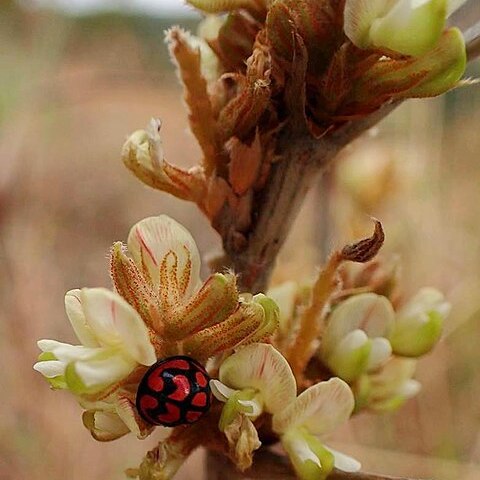Herb or scarcely woody subshrub, erect or occasionally subscandent, 0·3–1·8 m. tall.. Stems at first silky greyish or fulvous hairy, later glabrescent.. Leaflets 3, usually paler beneath, pubescent to densely velvety, sparsely to densely covered with small dark red glands; terminal leaflet elliptic to obovate, 2·7–15 cm. long, 1·3–7·5 cm. wide, obtuse to acuminate at the apex, cuneate or obtuse at the base; lateral leaflets obliquely ovate or elliptic, 2–15 cm. long, 1–6·5 cm. wide, obtuse to acuminate at the apex, rounded to cuneate at the base; petiole 1·5–7 cm. long, widened or almost winged; petiolules 3 mm. long.. Racemes fasciculate, dense, fulvous hairy; rhachis 1–2(–5) cm. long; bracts imbricate, ovate-elliptic, 4 mm. long, 2 mm. wide, multinerved; pedicels ± 2 mm. long.. Calyx-tube 1·5 mm. long; lobes linear, 3–6 mm. long.. Corolla greenish, yellowish-white or pink, sometimes with faint purple veining; standard oblong, 7–8 mm. long.. Pods 9–12 mm. long, 6 mm. wide, yellowish pubescent and also covered with dense but irregular dark red globules of a secretion which leaves an orange-red stain on touching.. Seeds black, more or less round, ± 1·5 mm. in diameter.. Fig. 115.
Herb or scarcely woody subshrub, erect or occasionally subscandent, 0.3-2(3) m tall. Stems at first silky greyish or fulvous hairy, later glabrescent. Leaflets 3, usually paler beneath, pubescent to densely velvety, sparsely to densely covered with small dark red glands; terminal leaflet 2.7-16.5 x 1.3-8 cm, elliptic to obovate, obtuse to acuminate at the apex, cuneate or obtuse at the base; lateral leaflets 2-15 x 1-6.5 cm, obliquely ovate or elliptic, obtuse to acuminate at the apex, rounded to cuneate at the base; petiole 1.5-7 cm long, widened or almost winged; petiolules 3 mm long. Racemes fasciculate, dense, fulvous hairy; rhachis 1-2(5) cm long; bracts imbricate, 4 x 2 mm, ovate-elliptic, multinerved; pedicels c. 2 mm long. Calyx tube 1.5 mm long; lobes 3-6 mm long, linear. Corolla greenish, yellowish-white or pink, sometimes with faint purple veining; standard 7-8 mm long, oblong. Pods 9-12 x 6 mm, yellowish pubescent and also covered with dense but irregular dark red globules of a secretion which leaves an orange-red stain on touching. Seeds black, c. 1.5 mm in diameter, ± round.
A herb or small shrub. It is erect and grows 1.8 m tall. It has deep roots that can form tubers. The leaves are alternate with 3 leaflets. The leaf stalk is 7 cm long. The leaflets are 2-15 cm long by 1-8 cm wide. The leaflet at the end is the largest. The flowers contain both sexes. The fruit is an inflated pod. It is 9-12 mm long by 6 mm wide. It contains 2 seeds. The seeds are round and 1.5 mm across. The fruit leaves stains when touched.
Leaflets 3, usually paler beneath, pubescent to densely velvety, sparsely to densely covered with small dark red glands; terminal leaflet 2.7–16.5 × 1.3–8 cm, elliptic to obovate, obtuse to acuminate at the apex, cuneate or obtuse at the base; lateral leaflets 2–15 × 1–6.5 cm, obliquely ovate or elliptic, obtuse to acuminate at the apex, rounded to cuneate at the base; petiole 1.5–7 cm long, widened or almost winged; petiolules 3 mm long.
Pods 9–12 × 6 mm, yellowish pubescent and also covered with dense but irregular dark red globules of a secretion which leaves an orange-red stain on touching.
Racemes fasciculate, dense, fulvous hairy; rhachis 1–2(5) cm long; bracts imbricate, 4 × 2 mm, ovate-elliptic, multinerved; pedicels c. 2 mm long.
Corolla greenish, yellowish-white or pink, sometimes with faint purple veining; standard 7–8 mm long, oblong.
Herb or scarcely woody subshrub, erect or occasionally subscandent, 0.3–2(3) m tall.
Stems at first silky greyish or fulvous hairy, later glabrescent.
Calyx tube 1.5 mm long; lobes 3–6 mm long, linear.
Seeds black, c. 1.5 mm in diameter, ± round.

